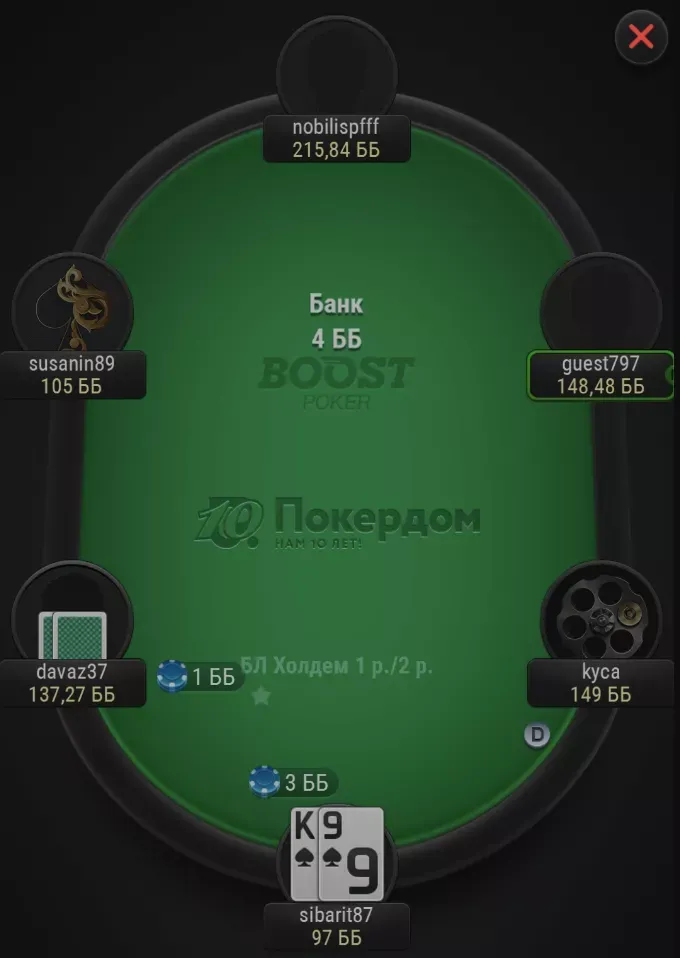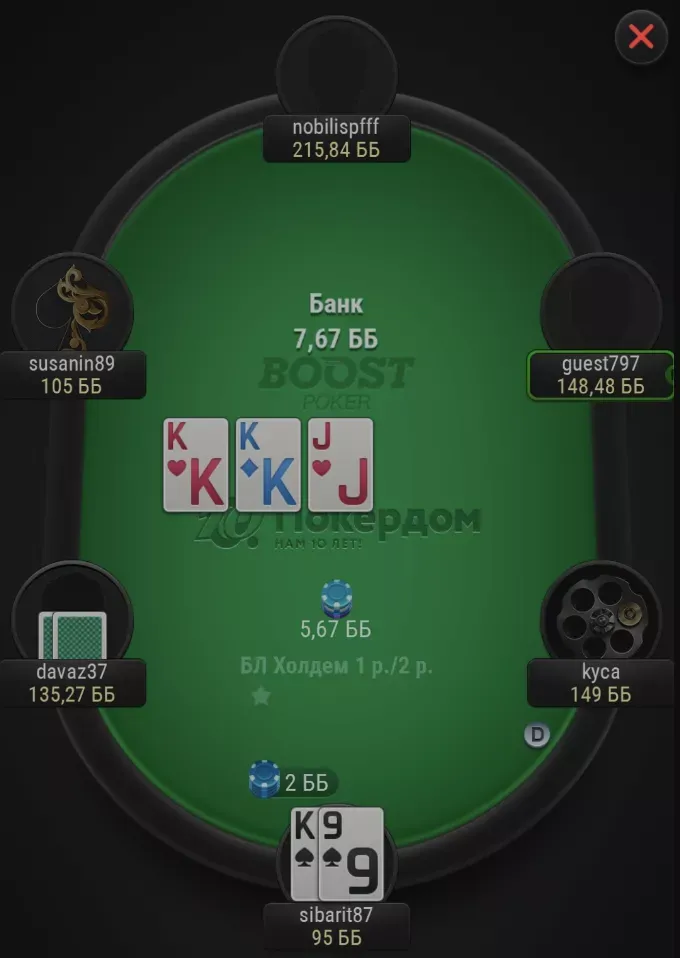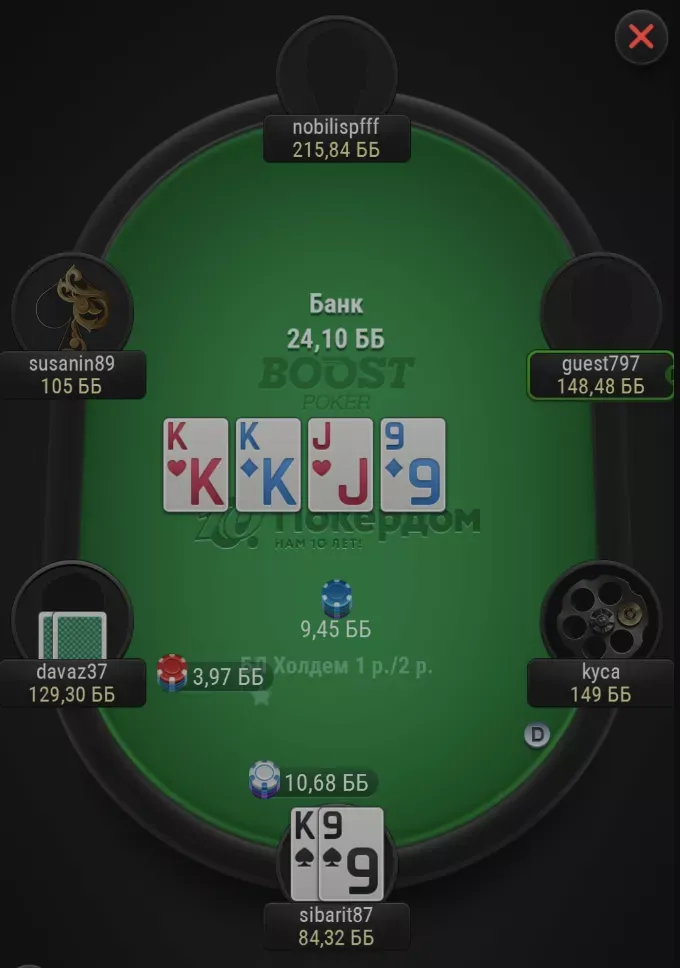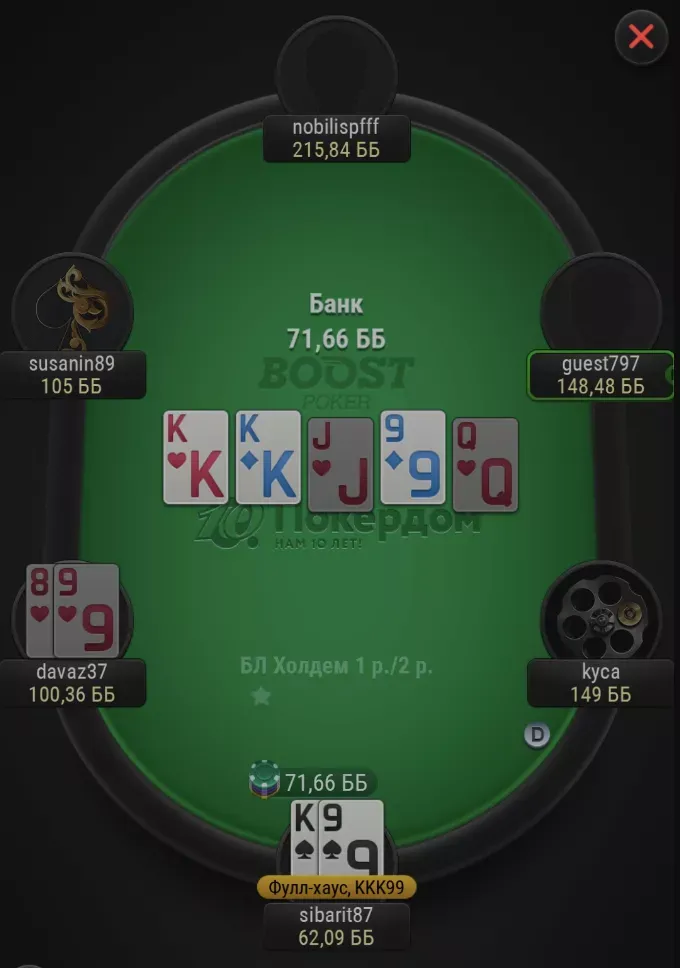Roman Sibarit87 hit the board perfectly but was too shy to place a tight bet out of position. GreenLine coach Alexander shpr0ta appreciated his analysis and explained in which cases you can play more brazenly.
Sibarit87
The hand was played on Pokerdom in boost, limit 1/2 ruble (around $0.01/$0.02). Opponent unknown.
Preflop

Standard open raise to 3bb from SB, opponent calls.
Sasha shpr0ta :
Standard. Sometimes you can use a larger sizing with SB, up to 4bb, to play hands out of position less often.
Flop

It was a good flop, but it feels like we're only going to be able to play a big pot if there's a cooler.
On such a structure I will play a small rangebet. The opponent simply calls. I do not expect frequent raises in position on such a board. We knocked out autofolds with the bet, I imagine the calling range as follows: Kx, Jx, flush draw, open-enders and gutshots. Plus, floats with small pocket pairs and a suited card are possible.
Sasha shpr0ta :
If we choose a linear strategy (rangebet), then the main sizing will indeed be small – a third or a quarter of the bank – as Hero does. A small exploit – on high paired boards, as Range Research shows, fold equity is usually a little higher, so you can be more brazen.
We really won't get many raises on such boards. But it's worth noting that even on textures where we expect to get a lot of raises, in reality there are still much fewer of them than the solver. This allows us to bet more often, pushing the equity of our hands to the turn, rather than play check-fold on the flop, for example.
Regarding the continuation range, it's important to understand that in general people in position are willing to call small bets, so I would also put some trash in the opponent's hand, as well as a lot of hands with one card in the suit, i.e. all sorts of backdoors.
Turn

I decided to check-raise. I thought that my opponent would definitely call his Kx and straights. If he understands that I played a flop rangebet on such a board, he can bluff his floats and draws. There is a risk that he can check a flush draw, but nothing ventured, nothing gained. It is possible that the check here is a mistake.
Sasha shpr0ta :
On paired boards, a bet+check or check+bet line is standard. It's not often that we can play bet+bet out of position on a pair. In this particular spot, you can also use a linear bet on the turn, lowering the sizing, betting a lot of jacks and even hitting a nine with additional equity.
I like the check. And I like the check-raise even more. I wouldn't continue slowplaying here, since opponents often don't bluff the river and won't be able to merge, for example, a strong jack. The opponent doesn't have a bluff or a merge – slowplay won't work. Plus, we have very good blockers – we don't cut his continuations with a flush draw and don't block second nuts – straights.
The opponent bets small. I decided that with strong combinations, trips, and straights, he will bet bigger, and this size is similar to a block bet with a pair on a or for a free showdown, so I chose a small raise size. And I think I was wrong – I should have raised bigger.
Agreed. I would choose a bigger raise. I would take into account that the opponent with a flush draw in position is ready to call almost any size, and the jack here is probably not elastic to the raise size, given the number of draws on the board.
He most likely doesn't have any naked pairs in his bet, they probably have additional equity. And there's no point in being afraid of knocking out just pairs, because they won't call anymore anyway. If the opponent decides to bet draws, and straights like that, he won't be able to get away with it anyway.
Yes, his small bet may include and , but they can be discounted preflop to a large extent, and both I and the board block them. Plus, I have nowhere to go against them.
would never fold in these positions.
The opponent calls our raise. With a high degree of probability, we can exclude straights from his range, since with such a combination he would most likely prefer to get it all in.
I assumed that by the river, the opponent's range consisted of flush draws, flush draws with hits, a small amount of Kx, and a very small amount of and .
River

The flush closed on the flop. I was very tempted to try a check-raise again, but I still decided to bet myself, not being too greedy. I figured that the opponent could check small flushes, and the board mostly blocks large ones. If he dragged small Kx in such a line, then he can check them too, and he will not fold to my bet. Well, there is no need to expect bluffs at this limit.
That's right. Opponent often won't be able to merge here, so check-raise may not work.
The question is tormenting me – perhaps it was worth aiming exclusively at the flush that got there and betting big or even considering an overbet?
I am for the overbet option. I think you missed the river by a lot. People often call very wide on the blinds. We can get an overbet called even from a straight, let alone flushes. Considering that we don't block either a straight or a flush, I would like to use the maximum sizing on the river. In such a situation, you can and should have a split on the river – upper sizes for the first nuts, middle and lower – for the second and third nuts.
The Showdown

- Increased first deposit bonus
- Increased rakeback and reloads
- Help with deposits and cashouts
- Access to private freerolls
- Round-the-clock support



















